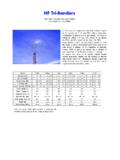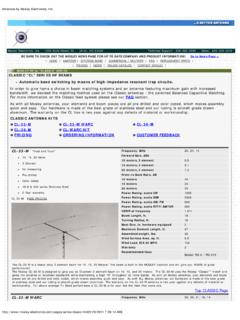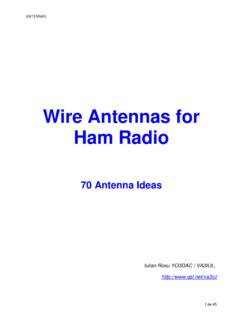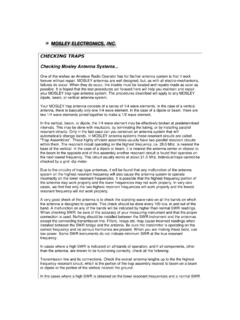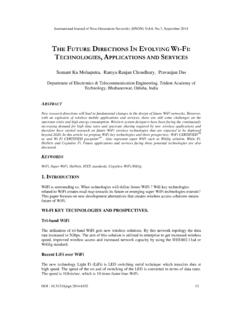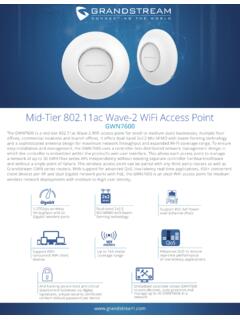Transcription of Tower and Antenna Wind Loading as a Function of …
1 July/Aug 2001 23Do you want to determine the maximum safe height ofyour freestanding Tower for any Antenna configuration as a Function of wind velocity? Use this approach to writea simple spreadsheet that will do the calculations in amatter of seconds and check the mast stress at the same Frank Travanty, W9 JCC808 Pendleton CtWaukesha, WI and AntennaWind Loading as aFunction of Height[Author s disclaimer: No liability isassumed for use of these calculationsthat results in bodily injury or propertyloss. If there are any questions or con-cerns regarding safety, they should bereferred to the manufacturer of yourtower.]After having a 54-foot, freestandingcrank-up Tower with a TH6 DXX beamup for 29 years in three differentstates, the wind finally blew hardenough to bend the lower portion of thetower.
2 The Tower was cranked down tomy away-from-home park position ofabout 30 feet at the time. Our highwinds seldom reach 60 mph; but thistime, there was a report of 100-mph-plus winds just a few blocks heavier-duty replacement towerwas immediately ordered and, ofcourse, new and larger antennas andmore of them. As winter was rapidlyapproaching, I put the Tower and an-tennas up as quickly as possible. I alsodecided it would be a good idea to cal-culate the bending moments caused bywind Loading on the Tower base as afunction of the Tower height. It s bet-ter to do these calculations before buy-ing the Tower and antennas. As thiswas an unscheduled event, though,necessity dictated that the new an-tenna system be ordered immediatelyso it could be installed before the wind began to howl inprevious years, I would make the tripoutdoors often in the middle of thenight to crank down the Tower .
3 Thetower-height/ wind -speed curves inthis article, along with a check of theweather forecast, let me sleep soundlywhile the wind howls, and I avoidthose midnight trips manufacturers of freestanding,crank-up towers specify the permis-sible wind Loading with some specificsurface area positioned at a specifieddistance above the top of the Tower ,with the Tower extended to its maxi-mum height. In many instances, thisdoes not reflect actual use, since manyhams stack antennas or place theirantennas at a height that does notmatch the specifications. Some ques-tions always arise when installing afreestanding crank-up Tower , such as: What is the effect of positioning oneor more antennas at various heightson the mast?
4 24 July/Aug 2001 Once the Antenna configuration hasbeen determined, how low must thetower be retracted to survive an an-ticipated wind velocity? Which will fail first because of windloading: the mast or the Tower ?ObjectivesMy specific objectives are:1. Determine the constant-momentcurve (safe-operating curve) at thebase of the Tower , based on the towermanufacturer s wind -load specifica-tion, as a Function of Tower heightand wind velocity for any generalizedantenna and mast Include the mast moment at thethrust bearing to permit analysis of what-if scenarios to determinewhether the mast or Tower is theweakest link or fuse of the mast analysis has been done pre-viously by several ,2,3,4,5 Theequations are included here for Provide the necessary equationsto easily calculate the Tower andmast bending moments by use of aspreadsheet.
5 And to generate a con-stant-moment plot for any of Tower wind Loadversus Tower HeightTower Height as a Function ofSection OverlapThis derivation is done for a three-section, freestanding Tower . It can befollowed for towers with a greater orlesser number of sections. Generalequations for any number of Tower sec-tions are provided in the sidebar Gen-eral Equations for the Tower Heightand Distance to Section Midpoints. Refer to Fig 1 for the following defi-nitions. All distances are in feet. Allforces are in = Distance to the midpoint of thebottom Tower section from the = Distance to the midpoint of themiddle Tower section from the = Distance to the midpoint of the toptower section from the Tower = wind -load force on the bottomtower section applied at its = wind -load force on the middletower section applied at its = wind -load force on the top towersection applied at its = Overlap distance of middlesection into bottom appear on page 1 Tower height as afunction of Velocity (MPH) Tower Height (ft) Tower Only (No Antennas or Mast)
6 Fig 2 A constant-moment curve for 19,600 ft-lb for the Tower only, with a gust factor = Overlap distance of top sectioninto middle = The Tower height from the base tothe top of the top section. (H canvary between 21 feet and 55 feet inthis example.)L = 21 feet (Length of individual towersections.)The necessary relationship betweentower height and Tower -section overlapcan now easily be determined as shownbelow and by inspection of Fig 1. Refer-July/Aug 2001 Velocity (MPH) Tower Height (ft) Tower SPECIFICATION 19,600 ft-Lb(56 ft * 350 lb)Tri-band Antenna at H + ft WARC Antenna at H + 15 ft 2-Meter Antenna at H + 16 ft Mast at H + 8 ftRotor at H - 4 ft Remote Switch at H + 0 ftH = Height of Crank-up Tower at Thrust ft2 distributed over 16 ft.
7 Of mastFig 3 Information for the mast 4 A constant-moment curve for a specific installation (gust factor ).ring to Fig 1, the height of the Tower , H,for a three-section Tower , is:H L LhLh=+ ()+ ()65(Eq 1)The telescoping sections are cabled totelescope uniformly, so the overlaps areequal, yielding h5=h6=h; the lengthis fixed at 21 feet. Substituting thesevalues,H becomes:Hhhh=+ ()+ ()= 21212163 2(Eq 2)Solving for the overlap h:hH= ()632(Eq 3)Distances to the Tower -SectionMidpoints from the Base, as aFunction of Tower HeightThe wind load on the Tower proper isdetermined by applying the totalhorizontal wind force on each towersection at the center of each of thesections.
8 So, referring to Fig 1 andstarting with the lowest section, thedistances from the base to the mid-points of the Tower sections as a func-tion of Tower overlap become:DLDLLhDLLhLh765==+ =+ ()+ 222(Eq 3A)Substituting Eq 3 into the expres-sions above, and letting L = 21 feet, thedistances from the base to the mid-points of the Tower sections (as a func-tion of Tower height) are:D7D6HD5H=== (Eq 3B) wind Surface Areasfor Individual Tower SectionsThese data are usually supplied inthe engineering calculations from thetower manufacturer. If not, they maybe calculated as described in Notes 1,2,3 and 4. For my Tower , the sectionwind Loading was obtained from the en-gineering calculations from the towermanufacturer, as listed the three Tower sections, theareas are:A Area of top section ftA Area of middle section ftA Area of bottom section ft222567======Forces on the Tower SectionsThe wind forces F5,F6 and F7 oneach of the Tower sections is calculated(see Note 1) using:FVA=()()g3902(Eq 4)where:F= Horizontal force, in = wind velocity in mph.
9 Includesgust factor (see Note 2) of (~112ft, hilly terrain)A = Surface area, in ft2 Moments Due to Tower Sections OnlyThe moment at the Tower base due tothe individual Tower -section momentsM5,M6 and M7 is calculated using:MFD=() (Eq 5)whereF is the force applied to eachtower section and D is the distance tothe midpoint of its respective towersection. Then the moment at the towerbase due to the Tower sections only is:MMMMFD FD FDTower=++=()()+()()+()()56755 66 77(Eq 6)The engineering specification fromthe Tower manufacturer is 350 lb ofwind force, located one foot above thefully extended Tower . This is the basis26 July/Aug 2001202530354045505560405060708090100110 120130140150160 wind Velocity (MPH) Tower Height (ft) Tower Only(No Antennas or Mast) ft2distributed over 16 ftof mast.
10 (Tribander, WARC, 2 M, and Accessories) ft2 at 1 ft above Tower30 ft2 at 1 ft above TowerFig 5 Overlayed constant-moment curves for a gust Velocity (MPH) Tower Height (ft) ft2distributed over 16 ftof mast.(Tribander, WARC, 2 M, and Accessories) Tower Only(No Antennas or Mast) ft2 at 1 ft above Tower30 ft2 at 1 ft above TowerFig 6 Overlayed constant-moment curves for a gust determining the safe bending mo-ment at the base of the Tower ; that is,(350 lb)(55 ft +1 ft) = 19,600 2 is a plot of wind force versustower height, for the rating of the towerdescribed above, with no additionalwind loads applied to the Tower and agust factor of curves of Fig 2 and the otherswere generated using a spreadsheeton a personal computer.
